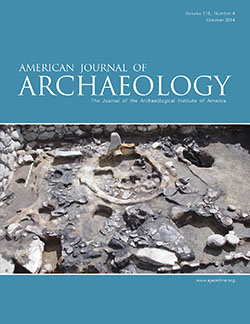AJA Open Access
BY-NCOctober 2014 (118.4)
Book Review
Living with Myths: The Imagery of Roman Sarcophagi
By Paul Zanker and Björn C. Ewald
Reviewed by Fred S. Kleiner
Living with Myths is an important and most welcome book on a major category of Roman monuments that, especially in the scholarly literature in English, has received much less attention than the more public manifestations of Roman art, such as portrait statues and busts and the reliefs on triumphal arches, altars, columns, and even coins.
This handsomely and abundantly illustrated book opens with a survey of the reuse and influence of Roman mythological sarcophagus reliefs in the later history of art. For art historians already familiar with the decisive impact of the sarcophagi in Pisa’s Camposanto on the marble pulpits of Nicola Pisano and the art of 13th-century Tuscany, this is well-trodden ground, but Zanker and Ewald provide an excellent account of this fascinating period, when medieval art became Renaissance art. The transformation would no doubt have occurred anyway, but it was certainly facilitated by the abundant examples of Roman reliefs that were readily available as models for Late Gothic and “Proto-Renaissance” Italian artists.
There follows a brief but valuable discussion of the reasons for the sudden flowering of sarcophagus reliefs during the first half of the second century C.E. and a concise account of Roman funerary customs, including familial visits to tombs and meals in honor of the dead.
The heart of the book, as expected, deals with the different mythological themes that appear on extant Roman sarcophagi. The authors argue—successfully in my opinion—that the themes fall under two major headings, namely stories in which death and mourning loom large and what Zanker and Ewald call “images of joyful worlds or happy circumstances” (37), which include Dionysiac episodes, cavorting creatures of the sea, and pastoral scenes. That the deceased, both men and women, identified themselves with the heroes and heroines depicted on the fronts, sides, and lids of the sarcophagi in which they were interred is established unequivocally by the portrait heads inserted in place of the idealized features of the chief protagonists of many of the Greek myths. The choice of many of the themes is easily understood. For example, it seems natural for a Roman man to have likened himself to Meleager, the legendary hunter who slayed the monstrous boar that was causing havoc in Calydonia, whose family and friends are shown grieving over his death. Likewise, who could be a better exemplum virtutis than Hercules, who achieves the impossible not once but 12 times in the course of his labors and then is rewarded with the gift of immortality? An ideal theme for a man’s coffin. What woman would not be flattered to appear in the guise of the blissfully sleeping Ariadne, whose beauty attracts the attention of the youthful god Dionysos? And both men and women would easily find a scene of the handsome Adonis dying in the arms of Venus, the immortal goddess of love, to be an appealing theme for the eternal home of their earthly remains.
Still, one is hard-pressed today to explain, as the authors try to do, why a Roman husband would pose as Achilles, the murderer of his lover Penthesilea, or why any mother would find anything positive about being associated with Niobe, who caused the death of all her children. Zanker and Ewald view the Achilles story as “a parable of a great love” and the hero as the model husband “who assists his wife even in the hour of her death” (48). The slaughter of the Niobids is meant to illustrate “the cruelty and senselessness of death” (369). The discussion of these issues in Living with Myths is the most sensitive and nuanced that I have read, but I remain surprised by the selection of these myths as featured themes on Roman sarcophagi and dissatisfied with the reasons that the authors suggest.
Some readers may also be puzzled, as I was, by the title of this book. Living with Myths seems a most curious choice for a treatise on the decoration of coffins. The authors argue that mythology permeated Roman life in general and that the same myths that appear on sarcophagi also adorn the walls of homes and that the allegorical funerary reliefs have something to say “not only about the dead but also about the living and about life” (ix). There is no doubt some truth to this assertion, but I think it is overstated. It would be desirable to have a comprehensive list of every mythological theme represented in Pompeian painting and to compare it with a similar list of subjects on Roman sarcophagi. I suspect that the overlap is not as great as the authors suggest. Moreover, the paintings all date prior to the eruption of Mount Vesuvius in 79 C.E., and the sarcophagi date to the second and third centuries. The two lists would therefore have a virtually zero chronological overlap, so the comparison is methodologically tenuous. A better question would be why mythological themes do not loom large in Roman funerary art of the Late Republic and Early Empire, when Romans were “living with myths” in their homes. Perhaps the authors will address that question in another context.
Fred S. Kleiner
Department of History of Art & Architecture
Boston University
Boston, Massachusetts 02215
fsk@bu.edu
